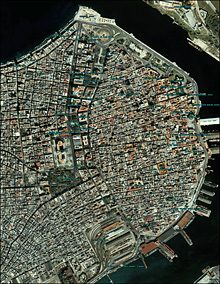 |
 |
 |
 Technology News | June 2007 Technology News | June 2007  
Digital Tools Bolster Property Claims Against Cuba
 Greg Allen - NPR.org Greg Allen - NPR.org

| 
Click image to enlarge. | | A satellite view of Havana. (Terrafly.com) |
Exiles from Castro's Cuba are using new technology to help them find their former homes in the island nation. Some have filed claims against frozen Cuban bank accounts in the United States for their losses, but coffers are running low after a few large payouts.

Thousands of companies and individuals have claims on file against the Cuban government. Many of them keep a watchful eye on the health of Fidel Castro, who gave his first interview this week since ceding power to his brother Raul and undergoing emergency surgery 10 months ago.

The prospect that the end of Castro's rule may hasten change in Cuba has cheered exiles living in South Florida and elsewhere who have a strong interest in the nation's future.

It is a point of principle among many Cuban exiles that while they long for their former home, they refuse to return — even for a visit — until Castro is gone and change begins to come to Cuba.

Many exiles fled Cuba after their homes and businesses were seized at gunpoint by the Communist regime. An ongoing exhibit of photographs in Miami's Little Havana neighborhood offers them the next best thing to a visit.

Mario Sanchez is a professor of computer sciences at Miami Dade College who conceived the exhibition, part of a project that marries computer technology with high-definition photography. It is aimed at helping Cuban-Americans locate and see images of their former homes.

As he steps closer to the large, wall-mounted satellite photo, it is clear Sanchez has a personal interest in the project.

"My house is in the Tamarindo area," he says.

Several years ago, Sanchez sent to the U.S. State Department copies of his photos, the deed for the Havana property, and an affidavit asserting a claim to his former home.

That process helped inspire his new project, in which Cuban exiles can use an interactive map to locate their former homes — and to file claims with the U.S. government.

At his home office in Miami Beach, Napthali Rishe shows how Cuban Americans can find their homes. At his laptop, he brings up the Web site he runs, Terrafly.com. A few clicks later, he is navigating around an interactive satellite map of Havana.

In some cases, the interactive map links to high-definition, street-level images of the property or others nearby, taken by U.S. volunteers and entered into the database.

Rishe says the project isn't political. It was intended to be an interactive archive that would document the current architecture of Havana, but which would also allow users to register claims to their former homes.

Attorney Pedro Freyre's family had four houses in Havana confiscated by the Castro regime. But he says now is not the time to press those claims.

Freyre also represents U.S. companies that had property confiscated by Cuba and which, like individual homeowners, have registered claims with the U.S. government.

In all, nearly 6,000 companies and individuals have claims on file with the State Department, claims that are waiting for some day in the future when Cuba and the United States are ready to discuss normalizing relations.

But while thousands wait, a few people have brought lawsuits against the Cuban government, and won.

One of them is Janet Ray Weininger, daughter of CIA pilot Thomas Ray, who was shot down during the 1961 Bay of Pigs operation and executed by Cuban authorities.

Weininger was just 6 when she last saw her father. It wasn't until the early 1970s that CIA officials told her family how he had died. By then, though still a teenager, she had begun trying to get Cuban authorities to return her father's body.

In 1979, Cuba released Thomas Ray's body. And then in 1996, Congress passed a law allowing U.S. citizens to sue foreign governments for terrorist acts. In Cuba's case, hundreds of millions of dollars have been held frozen in U.S. bank accounts since the 1960s.

Last year, Janet Ray Weininger received nearly $25 million disbursed from frozen Cuban accounts.

Two other lawsuits have also successfully tapped frozen Cuban funds. Families of members of the group Brothers to the Rescue who were shot down in their plane by Cuba in 1996 have received more than $90 million.

Also last year, the family of Howard Anderson, a U.S. businessman shot by a Cuban firing squad in 1961, received $67 million.

Other judgments against the Castro regime are pending. But Cuban and knowledgeable U.S. sources say there is little money left in Cuba's frozen accounts.

"There may be a little left, but it's certainly precious little," said Stuart Eizenstat, a former official in the Clinton and Carter administrations who has worked on claims involving foreign governments. His cases have included claims in Iran and Vietnam.

Eizenstat is critical of the lawsuits that have tapped Cuba's frozen funds, saying they unfairly bypassed thousands of other legitimate claims — and that they also undercut U.S. diplomatic leverage with Cuba.

Settling the thousands of claims pending against Cuba should not be much of an obstacle to normalization, Eizenstat said — when that day finally comes.

Given Cuba's poor economic state, Eizenstat says that any compensation received by claimants may be little more than token payments — and that ultimately, an apology may be as important as the money. | 
 | |
 |



